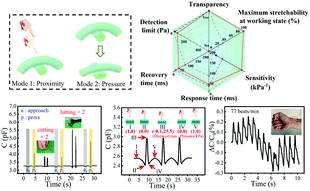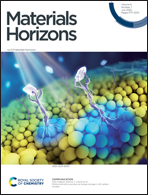An ultrastretchable, high-performance, and crosstalk-free proximity and pressure bimodal sensor based on ionic hydrogel fibers for human-machine interfaces†
Abstract
The traditional human-machine interaction mode of communicating solely with pressure sensors needs modification, especially at a time when COVID-19 is circulating globally. Here, a transparent, stretchable, resilient, and high-performance hydrogel fiber-based bimodal sensor is fabricated by using a polyacrylamide-alginate double network hydrogel, which features high sensitivity (3.17% cm−1), wide working range (18 cm), fast response/recovery speeds (90/90 ms) and good stability in proximity sensing, and impressive pressure sensing performance, including high sensitivity (0.91 kPa−1), short response/recovery time (40/40 ms), low detection limit (63 Pa) and good linearity. Moreover, the response switch between proximity/pressure modes is measured and non-interfering dual-mode detection is achieved. Notably, the stretchable bimodal sensor is capable of working under 100% tensile strain without degrading the sensing performance. Specifically, the proximity sensor shows good immunity to the strain, while the pressure sensitivity is even promoted. Furthermore, the sensor is tough enough to work normally after punctures from a knife and strikes from a wrench. Notably, the sensor can be used for gesture recognition and subtle pressure detection, such as small water droplets (10 mg), wrist pulse, etc. A 3 × 3 array is further shown for accurate spatial sensing and location identification, verifying the feasibility of its practical application.

- This article is part of the themed collections: Materials Horizons 2022 Most Popular Articles and 2023 Materials Horizons Lunar New Year collection


 Please wait while we load your content...
Please wait while we load your content...